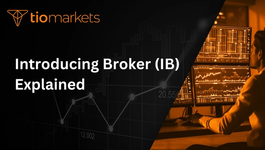Risk-free bond: Explained
BY TIOmarkets
|August 15, 2024In the world of trading, the term 'Risk-free bond' is a commonly used phrase. It refers to a type of investment that is considered to be free of credit risk. But what exactly does this mean? How does a risk-free bond work? And why is it important in trading? In this comprehensive glossary entry, we will delve deep into the concept of risk-free bonds, exploring its definition, characteristics, importance, and much more.
Understanding risk-free bonds is crucial for anyone involved in trading. It's a fundamental concept that can greatly influence your trading decisions and strategies. Whether you're a seasoned trader or a beginner in the field, gaining a thorough understanding of risk-free bonds can enhance your trading knowledge and skills. So, let's get started and explore this fascinating topic in detail.
Definition of Risk-Free Bond
A risk-free bond, as the name suggests, is a bond that is considered to have no risk of default. In other words, it's an investment where the investor is guaranteed to receive the principal and interest payments in full and on time. The concept of a risk-free bond is theoretical, as in reality, no investment is truly 100% risk-free. However, certain government bonds, particularly those issued by economically stable countries, are often considered as risk-free bonds because the likelihood of these governments defaulting on their debt is extremely low.
It's important to note that while risk-free bonds are considered free of credit risk, they are not immune to other types of risks, such as interest rate risk and inflation risk. We will delve into these risks in more detail later in this glossary entry.
Characteristics of Risk-Free Bonds
Risk-free bonds have certain distinctive characteristics that set them apart from other types of bonds. Firstly, they have a low yield. Since these bonds are considered to have virtually no risk, investors are willing to accept lower returns. Secondly, risk-free bonds have a high degree of liquidity. They are easy to buy and sell in the market, which makes them a popular choice among investors.
Another key characteristic of risk-free bonds is their role in determining the risk-free rate of return. This is a theoretical rate of return of an investment with zero risk, and it's often based on the yield of risk-free bonds. The risk-free rate is a fundamental concept in finance, used in various models and calculations.
The Importance of Risk-Free Bonds in Trading
Risk-free bonds play a crucial role in trading. They serve as a benchmark for other investments. The yield on a risk-free bond is often used as the 'risk-free rate', which is the minimum return an investor expects for any investment. The risk-free rate is used in various financial models and calculations, such as the Capital Asset Pricing Model (CAPM), which is used to determine the expected return of an investment.
Furthermore, risk-free bonds are an important part of a diversified investment portfolio. They can provide a steady stream of income with minimal risk, making them a popular choice for conservative investors. However, it's important to note that while risk-free bonds have a low risk of default, they are not immune to other types of risks, such as interest rate risk and inflation risk.
Interest Rate Risk
Interest rate risk refers to the risk that the value of a bond will decrease due to a rise in interest rates. When interest rates rise, the prices of existing bonds fall. This is because new bonds are issued at the higher interest rate, making the existing bonds with lower rates less attractive. Therefore, while risk-free bonds are free of credit risk, they are susceptible to interest rate risk.
Traders can manage interest rate risk in various ways. For example, they can diversify their bond portfolio by including bonds with different maturity dates. They can also use financial derivatives, such as interest rate swaps, to hedge against interest rate risk.
Inflation Risk
Inflation risk, also known as purchasing power risk, is the risk that the purchasing power of the cash flows from a bond will decrease due to inflation. In other words, the money you receive from the bond might be worth less in the future because of the rising cost of goods and services. This is a particularly relevant risk for long-term bonds.
There are several strategies to manage inflation risk. One common strategy is to invest in inflation-protected securities, such as Treasury Inflation-Protected Securities (TIPS) in the United States. These securities are designed to provide protection against inflation risk by adjusting the principal value of the bond based on changes in the Consumer Price Index (CPI).
Trading Risk-Free Bonds
Trading risk-free bonds involves buying and selling these securities in the bond market. Traders can profit from trading risk-free bonds by capitalizing on changes in interest rates. For example, if a trader anticipates that interest rates will fall, they can buy risk-free bonds. If their prediction is correct and interest rates do fall, the price of the bonds will rise, and the trader can sell the bonds for a profit.
However, trading risk-free bonds also involves risks. As we've discussed earlier, risk-free bonds are susceptible to interest rate risk and inflation risk. Therefore, it's important for traders to have a thorough understanding of these risks and how to manage them. Additionally, traders should also be aware of the transaction costs involved in trading bonds, such as brokerage fees and bid-ask spreads.
Strategies for Trading Risk-Free Bonds
There are several strategies that traders can use when trading risk-free bonds. One common strategy is the buy-and-hold strategy. This involves buying risk-free bonds and holding them until maturity. This strategy is suitable for conservative investors who are looking for a steady stream of income with minimal risk.
Another strategy is active trading, which involves buying and selling bonds to capitalize on price fluctuations. This strategy requires a good understanding of the bond market and the factors that influence bond prices. It's more suitable for experienced traders who are comfortable with taking on more risk.
Conclusion
In conclusion, risk-free bonds are a fundamental concept in trading. They are considered to have virtually no risk of default, making them a popular choice among conservative investors. However, they are not immune to other types of risks, such as interest rate risk and inflation risk. Understanding these risks and how to manage them is crucial for anyone involved in trading risk-free bonds.
Whether you're a seasoned trader or a beginner in the field, we hope this comprehensive glossary entry has enhanced your understanding of risk-free bonds. Remember, knowledge is power in trading. The more you understand about the market and its various components, the better equipped you'll be to make informed trading decisions.
Start Trading with Confidence at TIOmarkets
Now that you're equipped with a deeper understanding of risk-free bonds and their role in the trading world, it's time to put your knowledge into action. Join over 170,000 traders across 170 countries who have chosen TIOmarkets as their trusted forex broker. With our extensive range of educational resources and step-by-step guides, you'll learn how to trade more than 300 instruments across 5 markets with confidence. Experience trading with low fees on Forex, indices, stocks, commodities, and futures markets. Ready to embark on your trading journey? Create a Trading Account with TIOmarkets today and start trading effectively.

Risk disclaimer: CFDs are complex instruments and come with a high risk of losing money rapidly due to leverage. You should consider whether you understand how CFDs work and whether you can afford to take the high risk of losing your money. Never deposit more than you are prepared to lose. Professional client’s losses can exceed their deposit. Please see our risk warning policy and seek independent professional advice if you do not fully understand. This information is not directed or intended for distribution to or use by residents of certain countries/jurisdictions including, but not limited to, USA & OFAC. The Company holds the right to alter the aforementioned list of countries at its own discretion.
Join us on social media

Behind every blog post lies the combined experience of the people working at TIOmarkets. We are a team of dedicated industry professionals and financial markets enthusiasts committed to providing you with trading education and financial markets commentary. Our goal is to help empower you with the knowledge you need to trade in the markets effectively.





